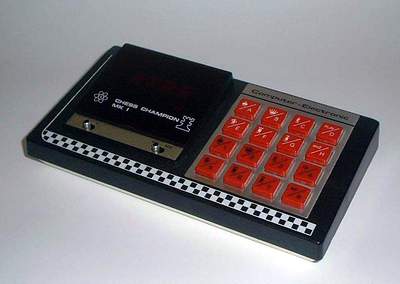PUTTING THINGS RIGHT (27 august 2006)
About four months ago I exchanged a few e-mails with German chess computer enthusiast Hans-Jürgen Schaefer. Our correspondence centered around the performances of two old but weak computers. The first was Mini Chess, a computer of about 25 years old, which looks like this:
Mini Chess
The other one, Chess Champion Mk 1, was even older and the first chess computer I ever bought. In the introduction page to the Overtom Chess Computer Collection, you can read about the mixed feelings that I have for this machine. After all, I paid quite a large sum of money for what would later turn out to be the weakest chess computer I have ever set eyes on.
 Chess Champion Mk 1
Chess Champion Mk 1
I thought it might be a good idea to organize a mini-match between these two "giants of the bottom", as Hans-Jürgen Schaefer so nicely put it.
When I wrote to Hans-Jürgen about my plan, he remarked that he had already held such a match and that Chess Champion had come out best.
You can imagine how surprised I was that such a weak computer as the Mk 1 had won any match, even against a weakling like Mini Chess. So I decided to stick to my plan and arrange a few games between them.
Mini Chess has only two levels. At level two, a move will take about 5 - 10 seconds. Chess Champion also has a second level, which takes 3 - 14 seconds according to the manual. During the match it became clear that this level gave both computers about the same amount of thinking time, although Mk 1 used up a little bit more time than its opponent.
The designers of Mini Chess seem to have done their best to make the keyboard as symmetrical as possible, which may be pleasant to the eye, but in practice, this lay-out appeared to be rather user-unfriendly. For instance, as you can see the text G7 is dangerously close to the New Game key:
Seeing this picture you won't be surprised to hear that at least two games ended because in Mini's memory all the chessmen suddenly stood on their starting positions in the middle of the game.
Another reason why games can go wrong easily is that Chess Champion accepts any moves. Even moves from an empty square to one occupied by a piece are accepted without any form of complaint: the piece is just removed from the board.
So more than half of the games played had to be discontinued because the position in the memory of one chess computer differed from that of the other.
But unlike the results of Hans-Jürgen's game, Mini Chess proved to be superior (or less inferior if you want) in all the games played. The two that I was able to record will be shown here.
On his 20th move, black sacrifices his queen to avoid forthcoming disaster, but the end is near anyway.
White: Mini Chess
Black: Chess Champion Mk 1
In the next game, black starts blundering on his fifth move: it is unclear why black does not play 5. .. e6 to defend f7. From then on things only go downhill for poor Chess Champion.
White: Mini Chess
Black Chess Champion Mk 1
Just like me, you may be wondering why Chess Champion had come out best in Hans-Jürgen's match. So I asked him about this.
His explanation was that his match was played within a larger framework of games in which all the computers were given half a minute thinking time. Unfortunately, Mini Chess had no higher level than ten seconds.
So it may be true that in the framework of Hans-Jürgen's match Mini Chess was weaker than Mk 1 because the latter was given much more time than Mini Chess. But if we want to put things in their right perspective it should be noted that if both computers are given equal thinking time, Mini is the stronger one.